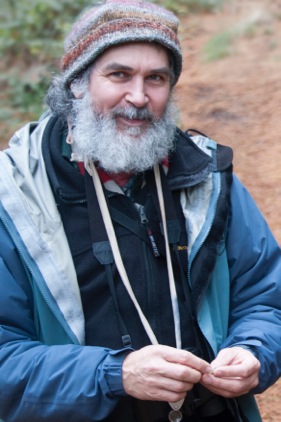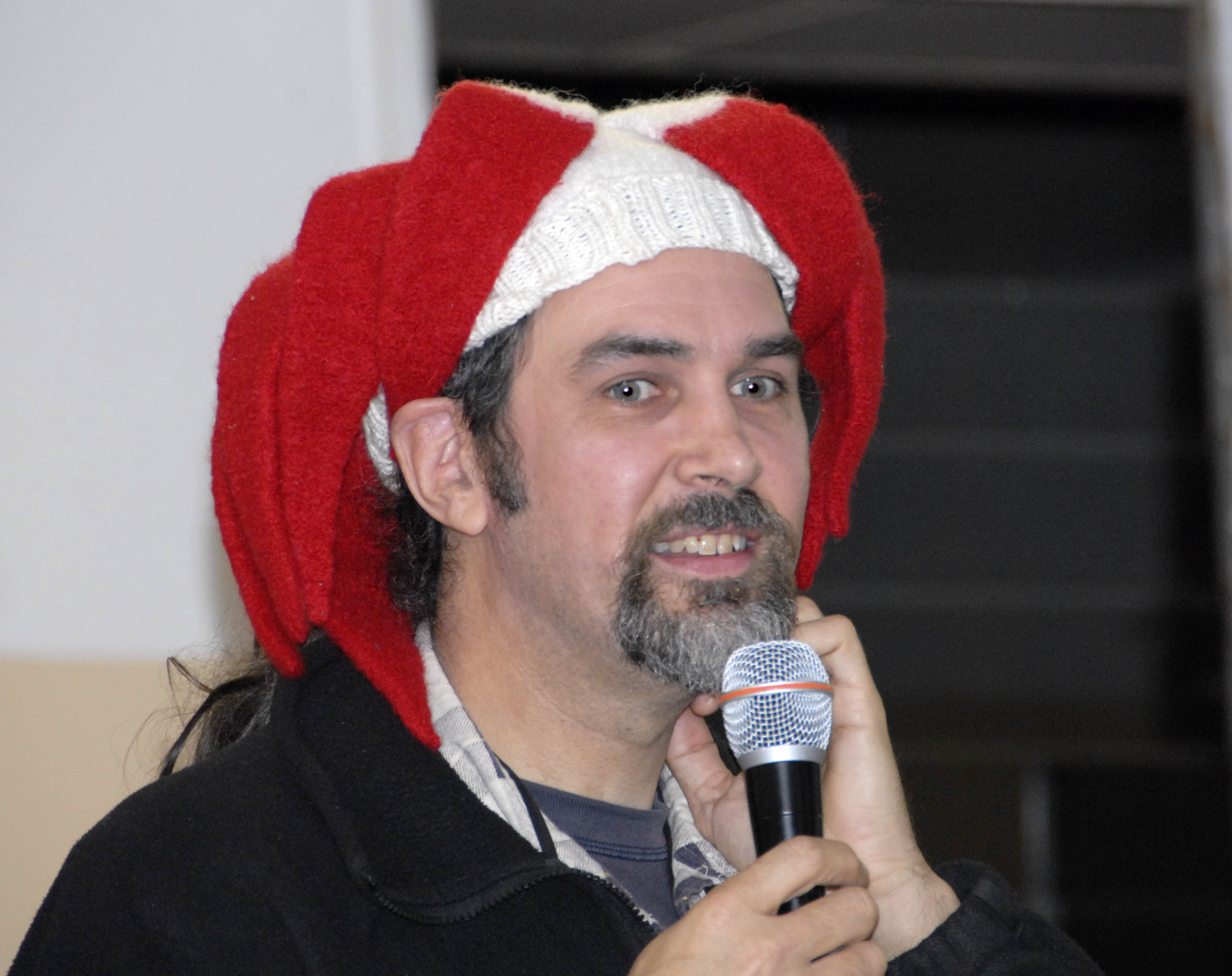A tribute to Tom May, Immediate Past President of Fungimap, by Pam Catcheside
Tom recently stepped down as President of Fungimap after over twenty years. I am sure that I speak for Fungimappers everywhere when I say a huge thank you to Tom for all he has done to put fungi on the map of Australia. Of course, Tom has done far more than this, he has brought together a community of people who may have had little knowledge of fungi and who are now joined by their interest, love and passion for the fungal kingdom.

I am going to be self-indulgent and reminisce about Tom and Fungimap. Apologies for my errors, omissions and people I have left out. I first met Tom in September 1996 at the inaugural meeting of the Australasian Mycological Society (AMS) in Melbourne. I had long had an interest in mycology and I found it thrilling that there was to be a society dedicated to fungi in Australia. Moreover, there was to be a field trip to Marysville in Victoria immediately after the meeting and of course I applied to join. The trip was organised by Tom and John Julian who had helped Tom in the establishment of Fungimap in 1995. The group of fourteen at Marysville included Tom and his partner Sara Maroske, John Julian, Bettye Rees, Katie Syme, Gretna Weste, David (Catcheside) and me and New Zealanders Peter Johnston, Peter Buchanan, Peter Austwick and Eric McKenzie. Going out into the bush with people who were excited about seeing fungi and having the fungi identified and explained was a joy. I could have been overwhelmed by the numbers of fungi we were finding, I wanted to know them all but Tom advised that it was better to get to know and research five species and then go on to others – reassuring and sensible advice that I try to pass on to others. Tom explained his vision that Fungimap would help in mapping Australia’s fungi. I and the others were hooked and I returned to Adelaide, ready to look for and send in records of the target species. Fungimap had started with a modest eight species which, by early 1997, was expanded to fifty and by 1999 another fifty species were added bringing the total to 100 species.
Fungimappers, as we became known, were kept in touch by the Fungimap Newsletter. This was edited by John Julian who also acted as administrator for Fungimap. Those who sent in records were acknowledged, thanked and encouraged – as they continue to be. All too often the efforts of enthusiastic volunteers, though they may be appreciated, are not always acknowledged and I think this is part of the philosophy that Tom has engendered which makes Fungimap such a viable and productive society.
Our next excursion in 1997 was a joint Field Naturalists Club of Victoria/Fungimap trip to Mount Buffalo National Park in the Australian Alps. The mission was to follow in the footsteps of Baron Ferdinand von Mueller, later director of the Royal Botanic Gardens, Melbourne and carry out a survey that was the first since 1853 to collect fungi in a systematic way from Mount Buffalo. There were 18 of us and it was a truly marvellous experience to be with fungal enthusiasts.
As always, Tom pointed out and identified fungi, explaining the roles that each played and sharing anecdotes about them.
Later in 1997 the Australasian Mycological Society held its conference in Adelaide. One excursion was to a site that David and I had recognised as being of significant fungal interest, Deep Creek Conservation Park. Very ambitiously I volunteered to be the list-keeper. After the foray I did as much research as I could to find the correct spelling of the names. Steccherinum ochraceumhad me totally flummoxed but Tom gently and kindly corrected, amongst other errors, my Steckerrinum. I also remember Tom’s finding Nothojafnea cryptotrichaand showing me the inconspicuous hairs on the outer receptacle of the red-brown cup. Perhaps it was then that my enthusiasm for cup and disc fungi started.

Tom’s encouragement gave me confidence to spend more time amongst the fungi. I think we all feel that if we are alone in trying to know and understand a difficult group of organisms such as the fungi, we do need help and Tom has always given me this whenever I have asked. He has never made me feel inadequate or criticised my often clumsy efforts. But I am just one person he has encouraged. He is unstinting in giving his time and expertise.
Even after the Marysville excursion in 1996 I felt I could go back to my Year 11 Biology students and pass on what knowledge I had gleaned. As I went on further trips with Tom, my enthusiasm for fungi grew and my students became perhaps not equally enthusiastic but certainly looked out for fungi and brought them to me, designating me a ‘Fun Guy’, my first experience of that joke.
Tom epitomises for me the ripple effect of a stone thrown into a pool. I have always looked upon him as my fungal mentor.
That role became more obvious when, in 1998, I went to a workshop run by Tom and Bruce Fuhrer in Bairnsdale, Victoria. That workshop cemented my future amongst the fungi. The school where I had been teaching closed at the end of the year, giving me the freedom to pursue the fungi. Tom always encouraged, answered questions but never forced anything. I think that is one of the strengths of Fungimap: people are encouraged, all contributions are welcomed but we are never made to feel we should do more if we are unable to do so.
By 1999 Fungimap was thriving and Tom decided that it was time to expand beyond the Melbourne headquarters and appoint Regional Co-ordinators. I was thrilled to be asked by Tom to be the Regional Co-ordinator for South Australia, along with Katrina Syme for Western Australia, Bettye Rees for New South Wales and David Ratkowsky for Tasmania.
John Julian and Pat Grey had been dealing with the increasing workload resulting from the success of Fungimap. In 2000 Katy Sommerville took over as the first Fungimap Co-ordinator. In April 2000 we had a get-together in Mount Field National Park, Tasmania, with Tom, Katy, Regional Co-ordinators and others. We didn’t really know each other well and Tom had suggested that each of us should choose a fungus and act it out for the others to guess its identity. The ice was well and truly broken when Bettye Rees brought out one long red and two round white balloons to demonstrate Phallus rubicundus. Since and before then there has been a relaxed joyousness about Fungimap events, with Tom just being there in a comfortable way.
In 2002 it was my pleasure that we had another get-together, this time in Adelaide and, apart from planning, we visited Deep Creek again, Belair National Park and Kuitpo Forest. Each time, Tom’s phenomenal knowledge was such a huge advantage. I would not have recognised Leucopaxillus lilacinus, the first time this species had been recorded in South Australia. Later, in 2008, with Tom’s encouragement I organised surveys on Kangaroo Island. A group of twelve Fungimappers from all over Australia gave their time and expertise to help with the documentation of the island’s fungi. Then there were the Fungimap conferences, the first in 2001 in Denmark, WA. This was a wonderful affair, organised superbly by Katie Syme which demonstrated the confident, vibrant society that, under Tom’s guidance, Fungimap had become.

In between conferences there were surveys in Tasmania: to the Tarkine in 2005 (sponsored by Australian Geographic), 2006, 2012 and 2013 and to the Blue Tier region in 2010. There was the Queensland Fungi Festival in 2015. But the success of Fungimap has led to problems. Under its influence, regional groups and societies have grown up and now there is at least one in each State. Running conferences and events in this huge continent is expensive and requires much organisation. Tom has passed the baton on to others and it is up to all of us who care about the traditions and ethos of Fungimap to continue with his vision for the fungi of Australia.
While writing this, I have become more and more aware of how much Tom has done for and with Fungimap. He is Senior Botanist at the National Herbarium, Melbourne, a role with numerous and often arduous other duties. Tom’s vision has brought together professionals and amateurs to further develop the knowledge and understanding of Australia’s rich mycota. He has truly put Australian fungi on the map.
Thank you Tom.

